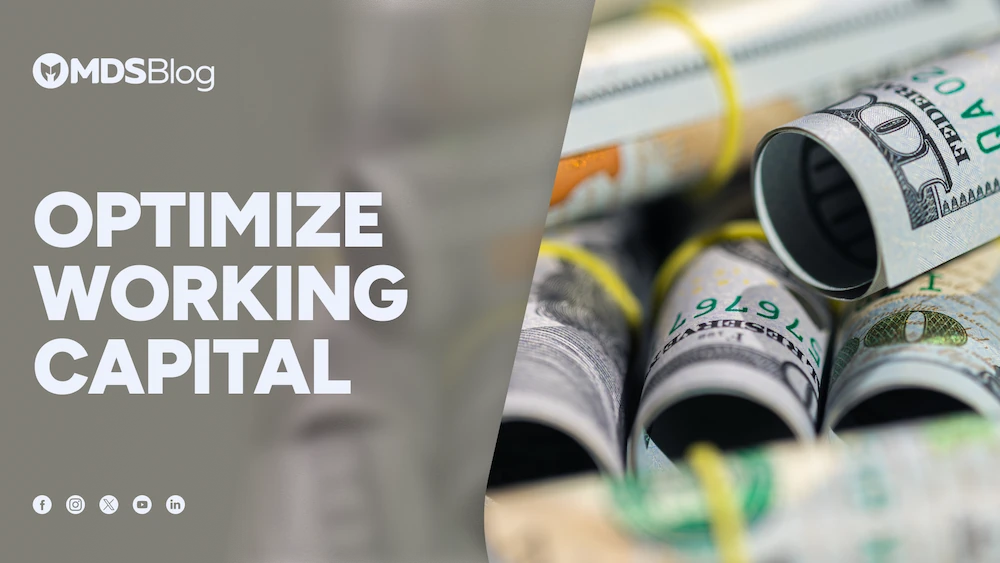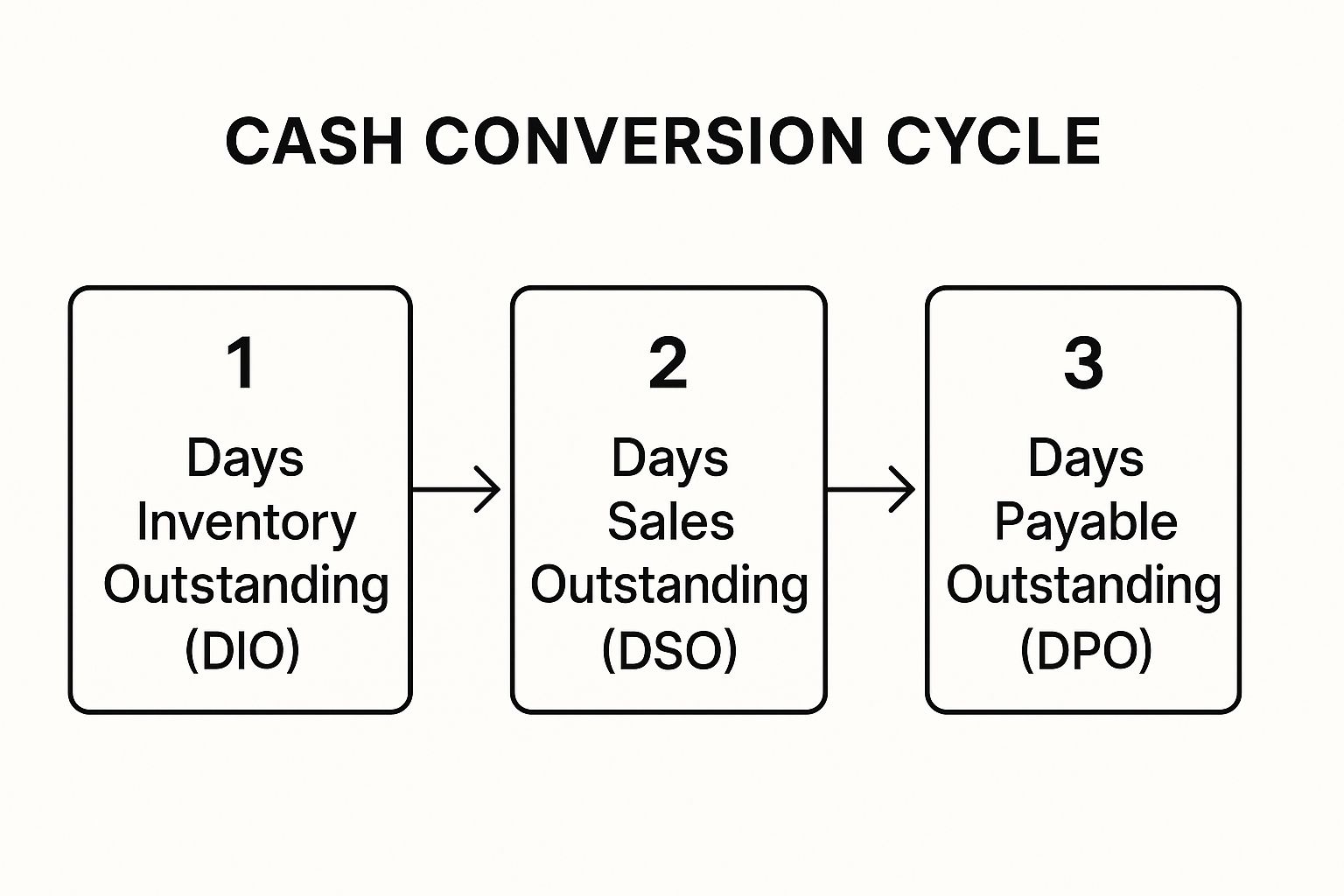Stay Updated with Everything about MDS
Thank you! Your submission has been received!
Oops! Something went wrong while submitting the form.

Chilat Doina
October 9, 2025
Working capital optimization is just a fancy way of saying you’re smartly managing the cash flowing in and out of your business. It's not about hoarding a mountain of cash in your bank account. It’s about making every single dollar pull its weight to fuel your growth, pay your suppliers on time, and keep the daily operations running without a hitch.

Think of your store’s working capital as its financial oxygen. It’s the lifeblood that pays for everything—new inventory, Facebook ads, shipping boxes, and your team's salaries. Without enough of it, even a wildly profitable brand can suddenly find itself in a cash crunch.
But here’s a common trap many founders fall into: assuming that more cash is always the answer. This leads to money just sitting there, collecting dust in a bank account when it could be put to work. That idle cash is a massive missed opportunity for reinvestment and scaling.
This is where working capital optimization comes in. It's the art and science of striking that perfect balance. You want enough cash to run everything smoothly, but not so much that it's tied up in dusty inventory or invoices you’re waiting on from wholesale partners.
The scale of this problem is staggering. A recent survey found an estimated $1.7 trillion in excess working capital is trapped on the balance sheets of just the 1,000 largest public companies in the U.S. This isn’t just a big-business issue; it’s a universal challenge of unlocking cash to finance growth. You can get the full picture by checking out The Hackett Group's 2025 U.S. Working Capital Survey.
For your e-commerce brand, that trapped cash could be the difference between launching that killer new product line or watching a competitor beat you to it.
To really get a handle on optimization, you have to know the moving parts. Every e-commerce business is a constant juggling act between three core elements that directly dictate its cash flow and overall health. Getting these three to work in harmony is the foundation of smart financial management.
Effective working capital management gives you the strategic advantage to sidestep common e-commerce nightmares like stockouts, slow-moving inventory, and unexpected cash flow crises. It’s how you go from constantly putting out fires to building a resilient, scalable business.
Let’s break down these three pillars. Understanding how they’re all connected is the first real step toward building a more efficient and profitable operation.
ComponentWhat It Is for E-CommerceWhy It MattersInventoryThe physical products on your shelves, from raw materials to the finished goods boxed up and ready to ship.This is almost always the biggest cash-eater for an e-commerce brand. Too much inventory and your capital is trapped; too little, and you're losing sales.Accounts ReceivableMoney that's owed to you. This is usually from B2B sales or just the delay while payment processors settle your funds.This is cash you've technically earned but can't spend yet. The faster you can collect it, the sooner you can put it back to work in your business.Accounts PayableMoney your business owes to others—suppliers, ad platforms like Google and Meta, and software providers.This is your short-term debt. Stretching out your payment terms (without ruining your supplier relationships) is a pro move to keep cash in your business longer.
Mastering the interplay between what you own (inventory), what you're owed (receivables), and what you owe (payables) is the name of the game. It’s how you unlock the cash you need to grow without taking on unnecessary debt or giving up equity.

When you strip it all down, optimizing your working capital is about pulling three main levers on your financial control panel. It’s not as complicated as it sounds. These levers are Accounts Receivable (AR), Accounts Payable (AP), and Inventory. Each one gives you direct control over how much cash you have on hand and how fast it moves through your e-commerce machine.
Mastering these levers is about creating a deliberate, strategic push and pull. You want to pull cash in faster, push payments out slower, and keep the cash tied up in your inventory to an absolute minimum. Getting this balance right is the heart and soul of smart working capital management.
This isn't just some abstract business school concept; it has a massive real-world impact. Even huge corporations wrestle with this. S&P 1500 companies are sitting on an estimated $707 billion in trapped cash—a staggering 40% increase since before the pandemic. Why? Largely due to inefficiency. 67% of firms reported it’s taking longer to get paid, and 76% saw their inventory sitting on shelves for longer. You can dig into the full working capital trends analysis to see the bigger picture. For your brand, tackling these same weak spots is the most direct way to unlock cash for growth.
Accounts Receivable is simply the money your business is owed but hasn't collected yet. For most direct-to-consumer brands, this is a non-issue since customers pay you instantly at checkout. But if you have a wholesale arm or offer B2B terms, AR suddenly becomes a critical lever. The goal here is simple: get paid faster.
Every day an invoice sits unpaid is a day that cash isn't working for you.
To speed things up, here are a few proven tactics:
Accounts Payable is the other side of the coin—it’s the money you owe to your suppliers, from your product manufacturer to your Facebook Ads account. Here, the objective is the exact opposite of AR: you want to strategically extend your payment terms to hold onto your cash for as long as possible. This isn't about dodging bills, but mastering their timing.
Think of it as a free, short-term loan from your suppliers.
Holding onto your cash for an extra 15 or 30 days can provide a vital buffer for your operations. It gives you more flexibility to invest in a new batch of inventory or a marketing campaign before the cash actually leaves your bank account.
Negotiating better terms is the key. Once you’ve built a strong, reliable relationship with a supplier, you earn the right to ask for Net 45 or even Net 60 terms instead of paying everything upfront. This one change can fundamentally improve your cash flow.
For just about every e-commerce founder, inventory is the most important—and most challenging—lever of all. It’s where the biggest chunk of your working capital is usually tied up. If you mismanage this lever, you’ll run into two very expensive problems:
The key to getting this lever right is data. Use your sales history and forecasting tools to truly understand the demand patterns for every single one of your SKUs. This allows you to adopt smarter inventory strategies, like Just-In-Time (JIT) ordering, where you purchase stock much closer to when you actually expect to sell it.
By cutting down the time your products sit on a shelf, you dramatically shorten the cycle of turning your cash investment back into revenue.
If you want to truly master your working capital, you need a compass. For any e-commerce business, that compass is the Cash Conversion Cycle (CCC). It’s a killer metric that tells the story of a single dollar as it journeys through your business—from the moment you spend it on inventory to the second it lands back in your bank account from a customer's purchase.
Think of it as your "time to cash." The CCC measures, in days, just how long your money is tied up before it starts earning its keep. A shorter cycle means your cash is working harder and faster, freeing up funds you can pour back into growth. But a long cycle? That means your cash is just sitting idle on warehouse shelves or locked up in unpaid invoices, acting like a brake on your business’s momentum.
To get a handle on your CCC, you need to understand its three core building blocks. Each one represents a different leg of your cash's journey, and tightening up any one of them will make your whole operation healthier and more efficient. And of course, getting this right requires a solid foundation in understanding financial statements, since that's where all the raw data comes from.
This infographic breaks down how a dollar flows through your business, showing how the three pieces of the CCC puzzle fit together.

As you can see, the cycle kicks off with inventory, flows through your sales, and then gets a little help from how long you take to pay your own suppliers.
Here’s a closer look at each part:
The formula that ties these three numbers together is refreshingly simple:
CCC = DIO + DSO - DPO
Let’s run the numbers with a quick example. Imagine you run an online shop selling custom-printed t-shirts:
Now, let's plug those into the formula:
CCC = 60 (DIO) + 0 (DSO) - 30 (DPO) = 30 days
What this tells you is that from the moment you pay your supplier for those blank tees, it takes a full 30 days for that cash to make its way back to your bank account through a sale. That 30-day gap is a period you have to finance out of your own pocket. The shorter you can make that gap, the less cash you need just to keep the lights on, and the more you have to spend on what really matters—growth. Exploring different cash flow management strategies can give you more firepower to shrink that gap even further.
https://www.youtube.com/embed/0fONene3OIA
Knowing your numbers is one thing, but actually putting that knowledge to work is what gets you paid. Moving from theory to action means having a few solid frameworks you can lean on right away. Before you even think about that, though, you absolutely need to know how to read company financial statements. It’s the only way to get a real diagnosis of where you stand.
Once you have that baseline, let's dive into three powerful strategies built specifically for e-commerce founders. Each one gives you a different lever to pull to unlock cash and get back to growing.
For most e-commerce brands, inventory is the single biggest cash-sucking monster in the business. The Dynamic Inventory Management framework is all about taming that beast, turning your stock from a static cost center into a fluid, cash-generating asset. This isn’t just about ordering less—it’s about ordering smarter.
The whole idea is to use data-driven demand forecasting and Just-In-Time (JIT) principles to absolutely slash your holding costs. Forget massive, infrequent orders based on a gut feeling. We're talking about smaller, more frequent purchases that actually line up with how fast your products are selling.
This approach directly crushes your Days Inventory Outstanding (DIO), which frees up a ton of cash. When you get this right, you can react instantly to sales trends, stop worrying about getting stuck with a mountain of unpopular products, and avoid those margin-killing clearance sales. To really nail this, you have to master the fundamentals of stock control, which is why our guide on inventory management best practices is required reading.
This next framework is all about the art of timing. You want to speed up the cash coming in while strategically slowing down the cash going out. It’s a delicate dance of managing your Accounts Receivable (AR) and Accounts Payable (AP) to create a much healthier cash conversion cycle.
Even if you're a direct-to-consumer brand, those tiny delays from payment processors can add up to a big problem. And if you have a wholesale arm? This becomes absolutely critical.
The goal is to close the gap between when you spend a dollar and when you get it back. By aligning your payables and receivables, you create a natural buffer that reduces your reliance on external funding to cover operational expenses.
Here’s how you can start putting this into practice:
Choosing the right framework depends entirely on your business model and your most pressing challenges. This table breaks down the three strategies to help you decide where to focus your energy first.
StrategyPrimary GoalBest For E-Commerce ModelPotential RiskDynamic Inventory ManagementFree up cash tied in stock; lower holding costs.Brands with a large catalog or seasonal products.Stock-outs if demand forecasting is inaccurate.Strategic Cash Flow TimingImprove the cash conversion cycle; create a self-funded buffer.Brands with a wholesale/B2B component or long lead times.Damaging supplier relationships if not managed carefully.Smart Financing & TechBuild operational resilience; fund growth opportunities.High-growth brands or those in volatile markets.Over-reliance on debt; tech costs can add up.
Ultimately, the most successful brands often blend elements from all three, creating a customized approach that fits their unique situation.
The final framework is an admission that things are rarely perfect, especially when you're growing fast or the market throws you a curveball. This is where modern technology and flexible financing come in to create a vital safety net.
This strategy is about using the right tools to get a real-time, crystal-clear view of your cash position while tapping into financing options that actually understand the e-commerce grind. It’s about building resilience so that a single supply chain hiccup doesn't send your entire operation into a tailspin.
To make this happen, you need to invest in a robust inventory management system that talks to your sales channels and your accounting software. This creates a single source of truth, eliminating the guesswork. On top of that, start exploring financing options beyond old-school bank loans. Things like revenue-based financing or lines of credit are designed for the ups and downs of e-commerce inventory cycles. These tools give you the agility to pounce on opportunities—like a big discount on a bulk buy from a supplier—without draining the cash you need to keep the lights on.

The theory is one thing, but the real magic happens when you see these strategies making a difference for brands just like yours. Let's get out of the weeds and into the real world to see how smart working capital optimization creates tangible wins in the trenches of e-commerce. These stories are a blueprint for turning financial management into a serious growth engine.
And it’s not just a nice-to-have. During tough economic times, the brands that get a handle on their working capital consistently blow past their peers. Just look at the 2008-2011 financial crisis: businesses with the most efficient cash conversion cycles saw their EPS grow 1.5 times higher than competitors. This isn't just about being efficient; it's about building a more resilient, valuable business. You can dig deeper into these working capital findings on J.P. Morgan's insights page.
First up, 'The Urban Apparel Co.', a fast-growing fashion brand that slammed into a very common wall. Sales were solid, but their cash was constantly stuck in inventory. They were ordering huge batches of clothing to get a better price per unit, but the strategy was backfiring—tying up thousands of dollars in slow-moving seasonal stock.
Their old way of doing things meant their Days Inventory Outstanding (DIO) was sitting at around 120 days. That's a full four months from the time they paid for a shirt to the time a customer bought it. This cash crunch left them with next to nothing for marketing, completely stalling their growth.
So, they switched to a data-driven inventory model. They invested in software that gave them a crystal-clear picture of sales velocity for every single SKU. This allowed them to ditch the massive quarterly orders and move to smaller, more frequent monthly buys based on what was actually selling.
The result? They hammered their DIO down from 120 days to just 45. That one change freed up over $50,000 in cash that was just collecting dust in their warehouse. They immediately pumped that capital into a high-impact digital ad campaign and doubled their new customer acquisition rate the very next quarter.
Now, let's look at 'Gourmet Goods Direct', a popular subscription box service. Their headache wasn't so much inventory as it was timing. They had to pay their artisan food suppliers upfront, but their customers paid them monthly. This created a constant, stressful cash flow gap.
Their solution was a two-pronged attack on their working capital cycle.
First, they went to work on their Days Payable Outstanding (DPO). After building up a solid payment history, they went back to their key suppliers. By showing off their reliability and consistent order volume, they successfully renegotiated payment terms from prepayment to Net 30. That simple conversation instantly gave them a 30-day cash buffer. Our guide on negotiating with suppliers has more tactical advice for these kinds of talks.
Key Takeaway: By strategically managing both what they owed and what they were owed, Gourmet Goods Direct went from constantly chasing cash to having a stable, predictable financial foundation ready for growth.
Second, they focused on their Days Sales Outstanding (DSO) by giving customers a reason to pay earlier. They launched a new annual subscription plan with a 15% discount for paying the full year upfront. It was a massive hit. Nearly 25% of their subscribers switched to the annual plan within three months.
This flood of cash at the start of the year completely wiped out their cash flow gap. They could fund inventory purchases without breaking a sweat and even had the capital to invest in developing new product partnerships.
Alright, let's get into the weeds. Moving from understanding concepts like working capital to actually putting them into practice is where the real questions pop up. I get it. So, let's cut through the noise and get straight to the practical answers for the questions I hear most often from e-commerce founders.
The single best place to start is to calculate your current Cash Conversion Cycle (CCC). Think of this number as your baseline, a quick health check that shows you exactly how many days your cash is stuck in the cycle of buying and selling stuff. You can't fix what you don't measure.
Once you’ve got that number, you need to dissect it into its three parts:
Look at each one honestly. Is your DIO way higher than you thought? Are your wholesale accounts taking forever to pay you? For most e-commerce brands, the biggest and fastest win is almost always hiding in the inventory. Focusing on shrinking your DIO is usually the most powerful first move you can make.
Absolutely. And it's a dangerous trap that catches a lot of fast-growing brands off guard. While you want to be lean, having too little working capital puts you in a nasty spot called overtrading. This is what happens when your sales are going through the roof, but you don't actually have the cash on hand to fund all that growth.
It's a bizarre paradox that can easily sink an otherwise successful business. Suddenly you can't place that critical inventory order, you're late paying your suppliers, or you can't even afford the marketing spend needed to keep the sales coming. Your P&L might look great, but the bank account is always dangerously close to zero.
The goal isn't just to slash working capital to the bone—it's about finding the sweet spot. You need enough cash to run your operations smoothly and handle surprises, but not so much that it's just sitting there doing nothing. This is exactly why consistent, forward-looking cash flow forecasting is a non-negotiable part of the game.
If you're in growth mode, checking your working capital can't be a once-a-year thing you cram in around tax time. Think of it more like checking the gauges on a race car engine while you're on the track.
A good rhythm is to review your key metrics—your CCC and its components—on a monthly basis. This gives you enough time to spot a negative trend before it spirals into a full-blown crisis. For example, if you see your DIO creeping up for two months straight, you can immediately dig in to see if a specific product line is tanking and do something about it.
For your day-to-day cash management, you should be looking at a weekly cash flow forecast. This constant monitoring helps you shift from being reactive (scrambling to pay a bill) to being proactive (making smart decisions so cash crunches never even happen).
Technology is a huge help here, and you don't need a massive enterprise budget to get started. A few key tools can give you the visibility and control you need to really nail your working capital.
When you integrate these tools, you're essentially building a real-time financial dashboard for your business. It takes the guesswork out of the equation and lets you make data-backed decisions that directly improve your cash flow and pour fuel on your growth. It’s all about working smarter, not just harder.
Ready to scale your e-commerce brand alongside the best in the business? Million Dollar Sellers is an exclusive community where 7-, 8-, and 9-figure founders share the exact strategies they use to optimize their operations and dominate their markets. Apply for membership and start growing faster at https://milliondollarsellers.com.
Join the Ecom Entrepreneur Community for Vetted 7-9 Figure Ecommerce Founders
Learn MoreYou may also like:
Learn more about our special events!
Check Events